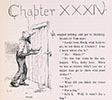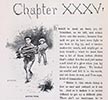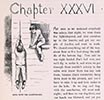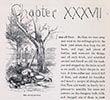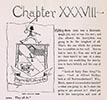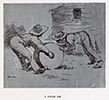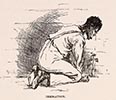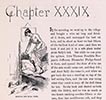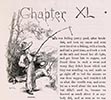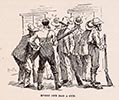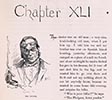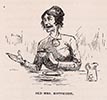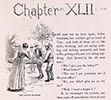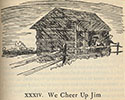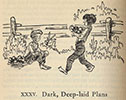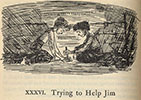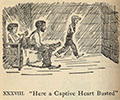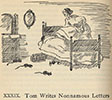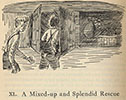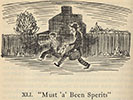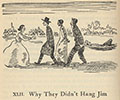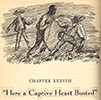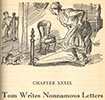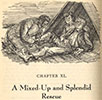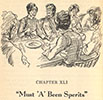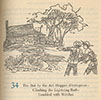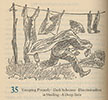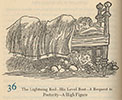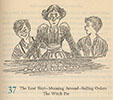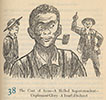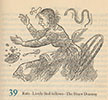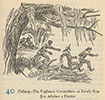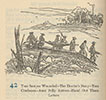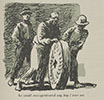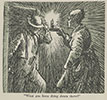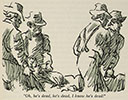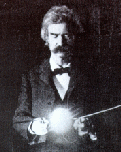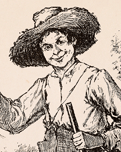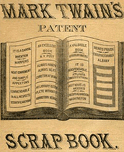It seems that MT's contemporaries were not troubled about the last section of Huck Finn -- Chapters 33-42, where Tom Sawyer re-enters the narrative and takes over center stage. Only one reviewer I've found expresses a reservation of any kind about "the long account of Tom Sawyer's artificial imitation of escapes from prison": to T.S. Perry its humor seems "somewhat forced." Four other contemporary reviewers praise these Tom Sawyer chapters: the prestigious critic Brander Matthews, for instance, calls the Evasion that Tom directs "most delightfully humorous." (See also the Montreal Star, the San Francisco Chronicle, and the New York World.) The live audiences that MT performed for during his 1884-1885 reading tour to promote the novel loved this episode. We have MT's own testimony about that: in letters home to his wife, he said that "the episode where Tom & Huck stock Jim's cabin with reptiles, & then set him free, in the night" is "the biggest card I've got in my whole repertoire." (For more of how MT's tour and the ending of Huck Finn, see Touring with Cable and Huck.)
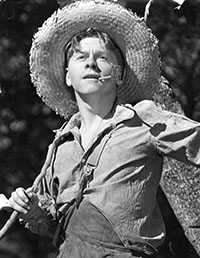
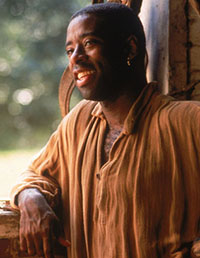
Twain scholar Charles Neider performed a somewhat similar operation in his 1985 edition of Huck Finn, cutting about 8000 words from chapters 33-42. Most scholars, however, know the problem can't be evaded so easily. In 1942 Bernard De Voto, probably the leading MT scholar of the time, indicted the ending as a betrayal of the achievement of the book's first 31 chapters: "In the whole reach of the English novel there is no more chilling descent." In their seminal appreciations of the novel later in the decade, T.S. Eliot and Lionel Trilling, two of America's most most prominent critical voices, defined and tried to resolve the problem of the ending as an aesthetic one. By the 1950s, however, at the same moment that the novel first came under attack on racial grounds, the problem was reframed as a social and even a moral one. In 1958, for example, noted Americanist Henry Nash Smith declared that Tom's "Evasion" reduces Jim "to the status of a 'darkey' in a minstrel show."
As campaigns to remove the novel from the classroom became more frequent during and after the 1970s, there has been a kind of "growing consensus" within the community of MT scholars about how to read the ending. The quotation is from Shelley Fisher Fishkin, who for the last three decades has been the novel's most outspoken champion. According to this reading, which first appeared in the 1960s, when modern students react negatively to the way the Evasion chapters treat freeing Jim as a kind of farce, they are responding exactly as MT wanted readers to react. The ending is not a betrayal of the novel's anti-racist agenda, but part of it. Readers who object to the treatment of Jim at the Phelps plantation are being radicalized to resist what the white South did to its formerly enslaved population after the failure of Reconstruction, as state legislatures passed the Jim Crow laws that segregated the schools, disenfranchised black voters, and, by implementing the convict-lease system that sentenced falsely convicted black prisoners to labor for white landowners, effectively re-enslaved thousands of black men.
It's fair to say that the more frequent became the attacks on the novel as racist, the more popular this reading became among MT's defenders. And it's easy to understand its attractiveness: it not only makes it possible for the teacher and MT himself to be on the same side as the alienated students, it also places all blame for the problem of the ending on American society: read as satire rather than burlesque, Tom's abuse of Jim's freedom is MT's protest against the white South's treatment of its African-American citizens. Even Toni Morrison, the Nobel-prize winning author of Beloved and other works, accepted this argument. Although in 1992 she had attacked the novel's ending's "humiliation" of Jim, four years later she sees the ending as a commentary on "the collapse of civil rights for blacks" in the 1880s, when "the nation, as well as Tom Sawyer, was deferring Jim's freedom in agonizing play."
Elsewhere I have written at length against the attempts to recuperate the Evasion this way. Attached as I am to my own argument, this isn't the place to rehearse it. However, as I was gathering together all the illustrated editions of the novel between 1885 and 1985, it occured to me that it might be worthwhile to put together an exhibit of the way those last chapters have been illustrated by the various artists who were hired to re-present MT's text visually. That's what you can explore here: 87 illustrations for chapters 33-42, drawn by 9 different artists. I am unable to resist making some comments of my own about each of their "readings" of the ending, but you should make up your own mind about how the choices they make, and the details that appear in their drawings, might shape the way readers of each edition "see" the ending. And at the bottom of this page I'll come back to the issue of the novel's place in America's classrooms.
